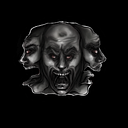Pagan Altar — Judgement of the Dead [Traditional Doom Metal / NWOBHM]
Formed in UK in 1978, this traditional doom metal / NWOBHM act is truly a cult band in every sense of the word. It took them more than a decade to record their debut album Judgement of the Dead (1982). It was certainly worth to wait. This music takes the listener on a journey through British pre-christian Pagan traditions. You become a part of a UK folk-horror classic like “The Wicker Man” or “Blood on Satan’s Claw” when you listen to this. Trevor Portch plays the bass. Drums are handled by John Mizrahi. Alan Jones is responsible for the music and the perfectly crafted guitar while his style of playing can be considered on the level of the best masters of classic hard-rock and heavy-metal and is often sadly overlooked by the general rock audience, for whom the bands themes seem too weird and obscure. The guitar is really what makes them sound outstanding. Terry Jones wrote the occult and pagan themed lyrics and was the vocalist. He passed away in 2015. His vocals are not going to be for everyone, the nasal singing can turn some modern listeners away, yet it perfectly carries across the themes of the lyrics and gives the music the needed flavor.
The title track “Pagan Altar” which opens the album is a great way to start. It meets the listener with eerie atmospheric chanting and invocation to the goetic demon Samael. And after that the audience is treated with a classic NWOBHM / Doom Metal hybrid greatness. The riff changes between trance-like meditative doom and the hard’n’heavy dynamic hooks. “In The Wake Of Armadeus” continues the album with a catchy tune which only picks up the tempo as it goes while keeping the doom-layed sabbath structure. The solo on it is amazing. “Judgement Of The Dead” — may be the best one here. A Celtic folk dirge opens with some gloomy synth before treating us to the dark guitar work. The lyrics reek of medieval dark tales: (Galleries of dead are smiling / Candlelight is shining / Judgement of the dead / Hooded corpses form the jury / Point with pent up fury / Judgement of the dead.) It is about the dead judging the living and ties in political modern themes, that were common after “summer of love” began to fade. Yet the narrative is much more subtle than in Sabbath’s classic Warpigs. The song feels like a old-fashioned ghost story while touching on modern issues. That is what good lyrics are supposed to be.
“The Black Mass” — another occult dirge, this time less pagan and more outright satanic. The slow heaviness gives an impressive theatrical feel. It is like a soundtrack to a play about black magic. Terry sings: (Through the corridors of darkness / On the wings of man’s desire / Conjured by the soulless ones / At the everlasting fire / Borne on waves of insanity / From man’s primeval past / The mantra of the tumult / Has awakened him at last)
The lyrics deal with the coming of a new age like in Kenneth Anger’s occult film “Lucifer Rising” which is based on the works of Alister Crowley, it declares the end of the Christian Era. (Oh, this is the age, the age of Satan / Oh, now that the twilight is done / Oh, now that Satan has come) Such lyrics were not a mere cliché when the song was composed but rather it was a new approach to dark romanticism in rock and early metal.
Night Rider is a mystical NWOBHM song which continues the mythological references which were established in the first part of the album. The second part of the song brings in more classic doom metal.
“Acoustics” — a pure folk tune sounds more happy than the rest of the album.
It adds to the folk and pagan feel.
Reincarnation touches on the subject of the myth of creation and the cyclical nature of life on earth and is in line with the heathen world view. The track is more mellow 70s rock yet it still packs a powerful doom melody. A good way to end the journey.
Pagan Altar were ahead of their time. The lyrics and themes they touched upon make them related to British dark-folk and the pagan / folk black metal. Both scenes came much later. The journey lies through the ghostly moors of the Celtic lands, through the ruins of ancient cities and dark forgotten grave mounds. This is a key album for the early development of doom metal. It displays the move from hippies’ optimistic “flower-power” to darker pessimistic occult ritualistic themes. This movement was started by bands like Pentagram, Black Sabbath, Witchfinder General and even earlier by Coven. All of these bands have one theme in common: the use of dark magic in the lyrical themes, although they do it in different ways. Pagan Altar’s debut displays one of the finer examples of this dark art. Many doom bands have referenced this band as an influence. Reverend Bizarre, Lord Vicar, Dawn Of Winter, Blood Ceremony — just to name a few. The modern listener needs to understand the context of the decades when the band recorded this, it will make the impact of the album greater and its significance more apparent.
by Anton “Vargtimmen” Bryukov
https://www.metal-archives.com/albums/Pagan_Altar/Judgement_of_the_Dead/418723
